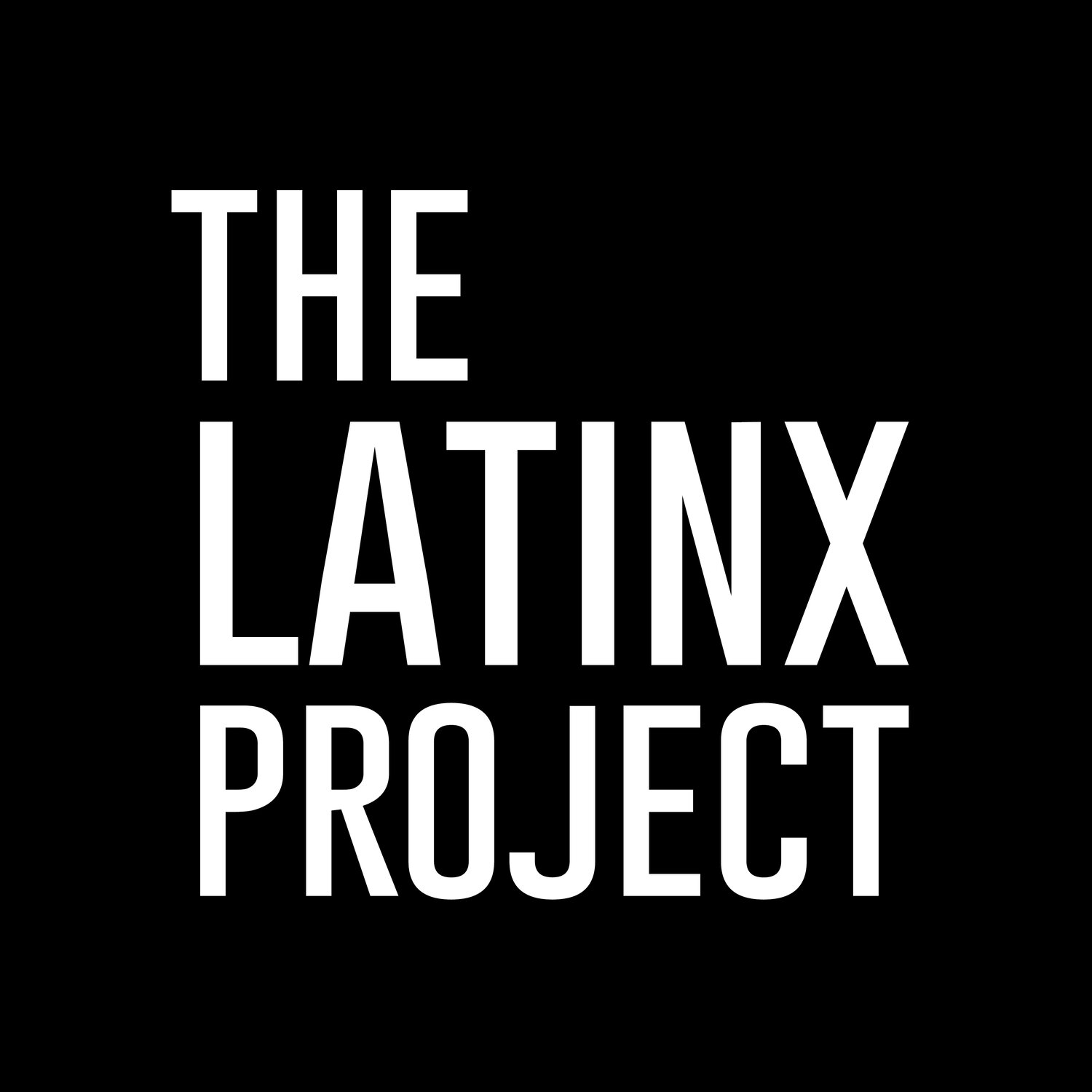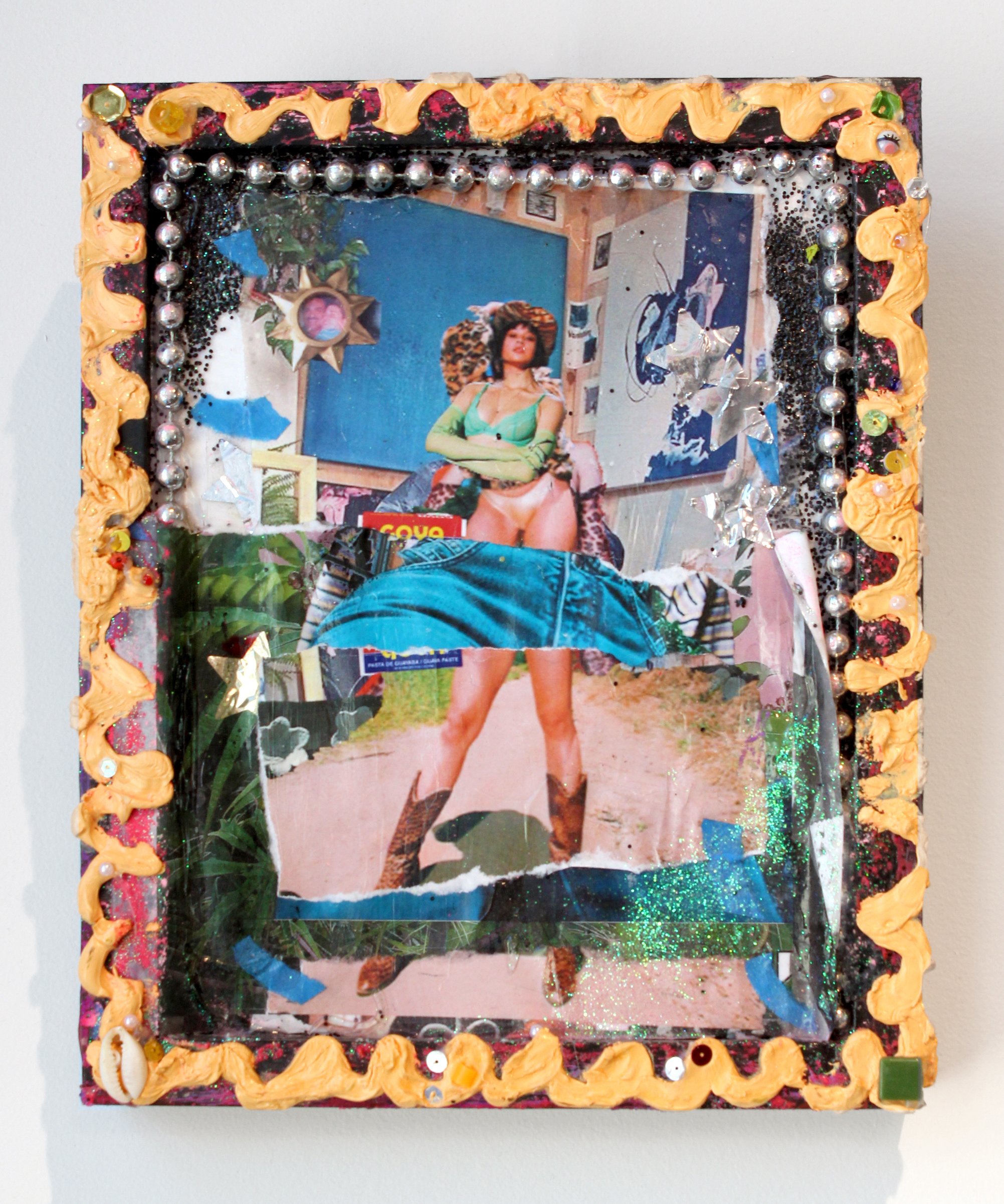On Being Home: Chloe Luisa Piñero’s World-Building
Two glamorous figures seem to emerge from a swirling expanse of pink and blue in With You (In the Clouds) (2022), the largest work in Chloe Luisa Piñero’s solo exhibition at Lather Hair Studios in Philadelphia, PA. In this mixed-media painting, collaged elements including images of gloved and manicured hands and sections from a pink feather boa bridge the spaces of the canvas and the salon. By acknowledging the viewer and situating the viewing encounter elsewhere—in the clouds—the title of this painting builds on the material entry points to implicate onlookers in the work’s ethereal scene. Depicting unreal spaces populated by fantastic figures, this and other works in the show explore ideas of self-fashioning, desire, and belonging.
Titled after one of the digital collages in the show, On Being Home is Piñero’s third solo exhibition and debuts three mixed media paintings (including With You) and several prints. The show also features a selection of work created over the last two years, including an installation starring Piñero’s recently published artist book, Looking for a Four Leaf Clover (2021).
The exhibition is situated in a functioning hair salon, which evokes the role of this site for earlier generations of women artists. Chicana artist Patssi Valdez, for example, understood the beauty shop as a site of empowerment and negotiated agency for women of color.¹ Rather than simply reifying hegemonic ideas of gender, Valdez understood the hair salon to be a stage for inscribing and transgressing normative femininity. With this appreciation of salons and beauty routines, Valdez was able to sustain an extensive engagement with self-fashioning as an integral and serious source for artistic practice, producing performances and wearable artworks that critiqued dominant ideas of beauty and art while affirming her experiences as a working-class, racialized, woman artist. While unable to afford the professional services of salons for most of her upbringing, Piñero shares Valdez’s appreciation of the empowering aspects of self-fashioning.
Rather than honing her sense of style in salons, Piñero’s beauty practices were iterated in the laboratory of the home. With the aid of older cousins, for whom she played the role of test subject for their styling experiments, Piñero came to appreciate the transformative powers of embellishment and adornment. Recalling these experiences as “feminizing experiments,” Piñero echoes Valdez’s understanding of self-fashioning as a negotiated practice. This idea is further explored in Piñero’s recent works.
In works such as Mirror and Salon (both 2022), Piñero invokes the instruments and spaces of beauty maintenance to highlight the negotiations that occur in the realm of appearances. Rather than directly representing the objects and spaces evoked in their titles, these works feature figures whose bodies refuse to cohere. The chimeric figure in Salon is comprised of digital cut outs from images Piñero assembled from the social media pages of models and “influencers” in addition to spreads and advertisements from printed erotica and magazines. In appropriating and re-assembling the images of bodily fragments of presumably beautiful women, Piñero’s collage gesture enacts a process of disidentification. Theorized by José Esteban Muñoz as a survival strategy, disidentification is a process that “scrambles and reconstructs the encoded message of a cultural text in a fashion that both exposes the encoded message’s universalizing and exclusionary machinations and recircuits its workings to account for, include, and empower minority identities and identifications.”² Piñero’s digital collages re-mix the images of women deemed conventionally attractive in order to disrupt the reification of the hegemonic tastes that shape the production and circulation of these images. The re-assembled fragments and resulting figures visualize the sort of negotiations Piñero performs as a queer subject of mixed ethnic heritage who does not seamlessly identify with the models or intended consumers of such images.
In addition to exploring self-fashioning and desire, Piñero’s show grapples with ideas of belonging through a consideration of space. The large windows of Lather Hair Studios let in ample natural light that glimmers off the glossy surfaces of Piñero’s digital prints. The light also highlights the subtle reliefs of the various found materials and hot glue lines adorning the surfaces of her paintings, facilitating a play of light and shadow that augments the tension between flatness and depth explored in these works. The materials adorning the mixed-media paintings and the ambiguous spaces painted or collaged across the works perform a similar process of disidentification as the constructed figures residing within them.
Returning to the title of the show, On Being Home, it becomes apparent that Piñero’s works are also examples of world-building. Simultaneously engaging digital, real, and imagined spaces, the works in this show build from the familiar to construct a world distinct from our own. The composite scene of Star (2020) blends together a patch of dirt, a passage of lush green vegetation, and the corner walls of some interior. While perhaps endowing the chimeric figure in Star with the allure and glamour of celebrity, the title of the work also invites us to take note of the shiny, metallic stars dotting the work and the bright, thick, wavy line framing the surface—almost reminiscent of a star’s corona. These elements bring the otherwise terrestrial scene into the realm of the heavenly and celestial.
Piñero builds on the representation of hybridized spaces through her material choices in works such as Bed (2021) and Untitled (Flower) (2022). The printed images on the surfaces of these paintings come from her archive of images assembled from social media and print materials, while the found materials are sourced from her home in Philadelphia and her family’s home neighborhoods in Puerto Rico. The collapsing of digital and lived space in Piñero’s paintings approximates the disorientation one may experience as a colonial subject surviving empire. Yet rather than dwell in despair, Piñero’s works offer a glimmer of a world distinct from the realities of life under imperialism and the ideas that shape and emanate from it. In pulling from various sources, Piñero simultaneously affirms the places she straddles while also grappling with the insufficiency of current reality.
The richly layered compositions of Piñero’s works engage a range of concepts, thereby lending themselves to an expansive array of interpretations. On Being Home’s location in an active hair salon invites a considered engagement with the themes of beauty and desire in her practice, as well as the stakes of these themes in our immediate context. While perhaps the present reality is not ideal, portals to other possibilities like the ones in Piñero’s works remind us that another world is possible.
On Being Home continues at Lather Hair Studios (2736 West Girard Ave, Philadelphia) through July 15, 2022. The exhibition was organized by Abbey Dernoga.
—
Footnotes
McMahon, Marci. “Patssi Valdez’s ‘A Room of One’s Own’: Self-Fashioning, Glamour, and Domesticity in the Museum and Hollywood.” In Domestic Negotiations: Gender, Nation, and Self-Fashioning in US Mexicana and Chicana Literature and Art, 136. New Brunswick: Rutgers University Press, 2013.
Muñoz, José Esteban. Introduction to Disidentifications: Queers of Color and the Performance of Politics, 31. Minneapolis: University of Minnesota Press, 1999.
Juan Omar Rodriguez (he/him) is a curator of contemporary art and Latinx cultural worker based in Philadelphia, PA. Juan Omar’s recent exhibition projects include Vernacular Glamour at the Cambridge Art Association, Linger and Flow at the Pennsylvania Academy of the Fine Arts, and TBD at Boston CyberArts in collaboration with the Boston LGBTQIA+ Artist Alliance. He received an M.A. in Art History and Museum Studies from Tufts University in 2019 and a B.A. in Neuroscience from Oberlin College in 2017.




